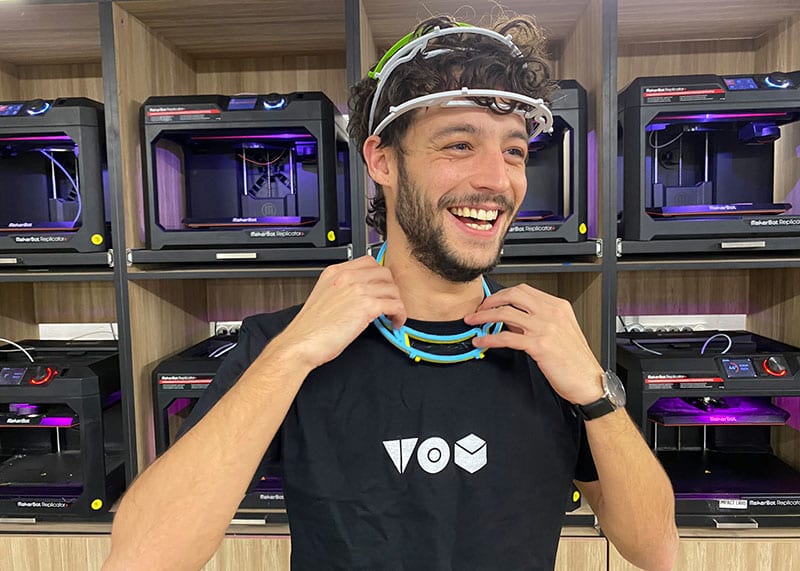The coronavirus pandemic caught healthcare systems around the world off guard and unprepared for such a quick-moving and devastating disease. Medical professionals from New York to Italy don’t have enough personal protective equipment (PPE), such as face masks and gowns, to protect themselves from infection. Hospitals are short on ventilators, which can help save lives when patients suffering from the respiratory disease are unable to breathe on their own.
In an effort to get more critical equipment into the hands of hospitals and emergency workers who need them, large automobile manufacturers in the U.S. have pledged to alter their production lines to make ventilators, gowns, and face masks—but that change hasn’t been instantaneous. In the meantime, grassroots movements of sewers and other makers, as well as businesses using technology they already have, are stepping up. These groups have been able to quickly and cost-effectively manufacture PPE digitally by using 3D printers.

Much like a regular printer, a 3D printer takes a design from a computer and uses those instructions to layer raw material—usually plastic filaments—on top of itself repeatedly to create a three-dimensional shape. A 3D printer can make almost anything, from plastic toys to prosthetic limbs.
Maker organizations such as Matterhackers and FormLabs are distributing 3D printing designs for items such as face masks and nasal swabs. HP, the printing company, is making face masks, nasal swabs, hands-free door openers, and respirator parts with their 3D printers. SmileDirectClub, the teledentistry company, which boasts one of the largest networks of 3D printers in the U.S., is pivoting to make face shields and masks. The company says its 60 industrial 3D printers can make roughly 7,500 face shields a day.
Making lifesaving equipment for vulnerable people has always been the mission of Tel Aviv–based maker community Tikkun Olam Makers (TOM), which established its Rapid Response Makers (RRM) initiative in response to this pandemic. The organization was founded in 2014 to use 3D printing to create items like prosthetics and wheelchairs for the disabled, elderly, and poor. TOM has established maker communities comprised of roughly 4,500 volunteers, in over 20 countries, who create TOM designs in local maker spaces.
The organization was founded to connect makers who wanted to help others with the technology and resources required. “We wanted to connect these two movements,” says Roy Goldenberg, community development director at TOM, of the organization’s founding. “People willing to give their time to help those at the bottom of the pyramid, the most vulnerable, and a shift in technology that allows us to manufacture these solutions [such as prosthetics] all around the world.”
That shift in technology is the rise of the 3D printer. While 3D printing technology has existed since the 1980s, it’s only in the past seven years or so that these devices have become so user-friendly and affordable that they’re practically mainstream. They cost as little as $250, and even children can learn how to use them.
The 3D printing technology used by TOM and others allows them to produce supplies faster and at a lower cost than traditional manufacturing facilities. Factories generally manufacture items—say, a plastic food container lid—based on a mold, which itself costs up to thousands of dollars to make. When that item is produced hundreds of thousands of times, that high cost is spread out over time, making it cost efficient for a factory. But during a crisis, manufacturers don’t have the time or resources to ramp up immediately.
3D printers, on the other hand, rely on digital designs, many of which circulate on online libraries, rather than molds. That plastic food container lid, for example, could be made from just $5 of raw material in a 3D printer, says Goldenberg.
When the COVID-19 pandemic hit, TOM, a WeWork member in Tel Aviv and New York City, decided to “create our own maker army” to provide medical professionals with much-needed supplies, Goldenberg says.
The central TOM team in Israel prototyped designs, delivered them to local hospitals to test, and then quickly iterated on the designs based on user feedback. The tweaked designs were uploaded to their open-source online database and distributed to TOM’s global network of makers. Right now the most popular design being printed by TOM’s global maker network is a face shield: a plastic covering attached to a visor that protects a wearer’s entire face. As of mid-April, the organization has donated more than 15,000 face shields around the world. That includes nearly 3,000 in Israel, over 4,000 in Mexico, and 5,000 in Serbia.
Makers say that the most difficult part of the grassroots movement to make PPE is the operations and logistics of getting material to makers and products to hospitals. And much like a regular printer, it’s not the 3D printer that’s costly, but the raw materials, or plastic filaments, that feed into it.

“We are short of 40,000 face shields in Israel,” says Goldenberg of TOM. “Our bottleneck is mostly around finding resources to get raw materials. It’s not because we don’t have enough 3D printers, but because we don’t have enough raw materials.” The organization is accepting donations that will go toward procuring these materials for their maker communities around the world.
Goldenberg emphasizes that these efforts are not meant to replace factories, but to step in swiftly when factories are unable to do so. “It takes time and effort for factories to move. In the meantime, the situation needs a quick response,” he says. “We’re living in a unique time. That requires unique behavior, engagement, and support from around the world.”
Anjie Zheng is the editor of Ideas by WeWork. Previously she was a reporter for the Wall Street Journal. Her work has also appeared in Fast Company, Quartz, and LitHub.







